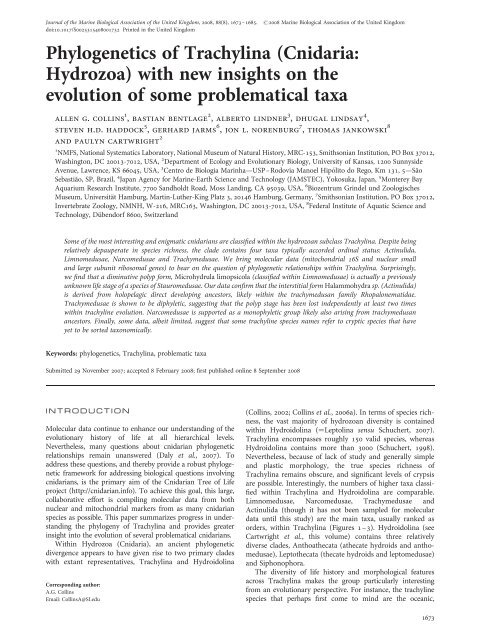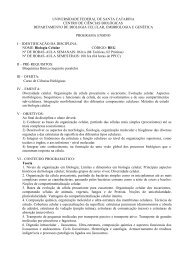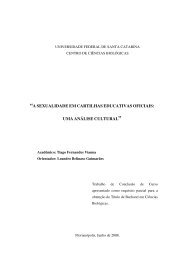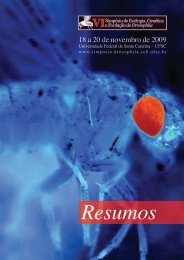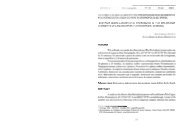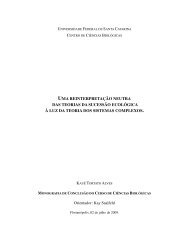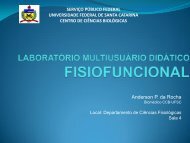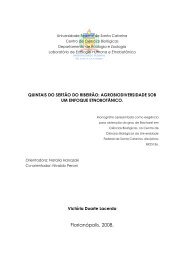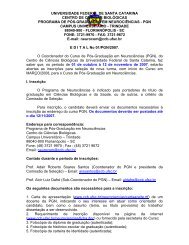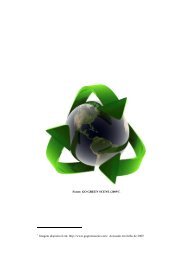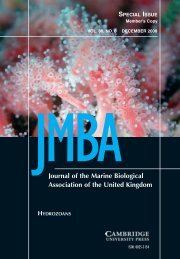Phylogenetics of Trachylina (Cnidaria: Hydrozoa) with new insights ...
Phylogenetics of Trachylina (Cnidaria: Hydrozoa) with new insights ...
Phylogenetics of Trachylina (Cnidaria: Hydrozoa) with new insights ...
- No tags were found...
You also want an ePaper? Increase the reach of your titles
YUMPU automatically turns print PDFs into web optimized ePapers that Google loves.
Journal <strong>of</strong> the Marine Biological Association <strong>of</strong> the United Kingdom, 2008, 88(8), 1673–1685.doi:10.1017/S0025315408001732 Printed in the United Kingdom#2008 Marine Biological Association <strong>of</strong> the United Kingdom<strong>Phylogenetics</strong> <strong>of</strong> <strong>Trachylina</strong> (<strong>Cnidaria</strong>:<strong>Hydrozoa</strong>) <strong>with</strong> <strong>new</strong> <strong>insights</strong> on theevolution <strong>of</strong> some problematical taxaallen g. collins 1 , bastian bentlage 2 , alberto lindner 3 , dhugal lindsay 4 ,steven h.d. haddock 5 , gerhard jarms 6 , jon l. norenburg 7 , thomas jankowski 8and paulyn cartwright 21 NMFS, National Systematics Laboratory, National Museum <strong>of</strong> Natural History, MRC-153, Smithsonian Institution, PO Box 37012,Washington, DC 20013-7012, USA, 2 Department <strong>of</strong> Ecology and Evolutionary Biology, University <strong>of</strong> Kansas, 1200 SunnysideAvenue, Lawrence, KS 66045, USA, 3 Centro de Biologia Marinha—USP–Rodovia Manoel Hipólito do Rego, Km 131, 5—SãoSebastião, SP, Brazil, 4 Japan Agency for Marine-Earth Science and Technology (JAMSTEC), Yokosuka, Japan, 5 Monterey BayAquarium Research Institute, 7700 Sandholdt Road, Moss Landing, CA 95039, USA, 6 Biozentrum Grindel und ZoologischesMuseum, Universität Hamburg, Martin-Luther-King Platz 3, 20146 Hamburg, Germany, 7 Smithsonian Institution, PO Box 37012,Invertebrate Zoology, NMNH, W-216, MRC163, Washington, DC 20013-7012, USA, 8 Federal Institute <strong>of</strong> Aquatic Science andTechnology, Dübendorf 8600, SwitzerlandSome <strong>of</strong> the most interesting and enigmatic cnidarians are classified <strong>with</strong>in the hydrozoan subclass <strong>Trachylina</strong>. Despite beingrelatively depauperate in species richness, the clade contains four taxa typically accorded ordinal status: Actinulida,Limnomedusae, Narcomedusae and Trachymedusae. We bring molecular data (mitochondrial 16S and nuclear smalland large subunit ribosomal genes) to bear on the question <strong>of</strong> phylogenetic relationships <strong>with</strong>in <strong>Trachylina</strong>. Surprisingly,we find that a diminutive polyp form, Microhydrula limopsicola (classified <strong>with</strong>in Limnomedusae) is actually a previouslyunknown life stage <strong>of</strong> a species <strong>of</strong> Stauromedusae. Our data confirm that the interstitial form Halammohydra sp. (Actinulida)is derived from holopelagic direct developing ancestors, likely <strong>with</strong>in the trachymedusan family Rhopalonematidae.Trachymedusae is shown to be diphyletic, suggesting that the polyp stage has been lost independently at least two times<strong>with</strong>in trachyline evolution. Narcomedusae is supported as a monophyletic group likely also arising from trachymedusanancestors. Finally, some data, albeit limited, suggest that some trachyline species names refer to cryptic species that haveyet to be sorted taxonomically.Keywords: phylogenetics, <strong>Trachylina</strong>, problematic taxaSubmitted 29 November 2007; accepted 8 February 2008; first published online 8 September 2008I N T R O D U C T I O NMolecular data continue to enhance our understanding <strong>of</strong> theevolutionary history <strong>of</strong> life at all hierarchical levels.Nevertheless, many questions about cnidarian phylogeneticrelationships remain unanswered (Daly et al., 2007). Toaddress these questions, and thereby provide a robust phylogeneticframework for addressing biological questions involvingcnidarians, is the primary aim <strong>of</strong> the <strong>Cnidaria</strong>n Tree <strong>of</strong> Lifeproject (http://cnidarian.info). To achieve this goal, this large,collaborative effort is compiling molecular data from bothnuclear and mitochondrial markers from as many cnidarianspecies as possible. This paper summarizes progress in understandingthe phylogeny <strong>of</strong> <strong>Trachylina</strong> and provides greaterinsight into the evolution <strong>of</strong> several problematical cnidarians.Within <strong>Hydrozoa</strong> (<strong>Cnidaria</strong>), an ancient phylogeneticdivergence appears to have given rise to two primary clades<strong>with</strong> extant representatives, <strong>Trachylina</strong> and HydroidolinaCorresponding author:A.G. CollinsEmail: CollinsA@SI.edu(Collins, 2002; Collins et al., 2006a). In terms <strong>of</strong> species richness,the vast majority <strong>of</strong> hydrozoan diversity is contained<strong>with</strong>in Hydroidolina (¼Leptolina sensu Schuchert, 2007).<strong>Trachylina</strong> encompasses roughly 150 valid species, whereasHydroidolina contains more than 3000 (Schuchert, 1998).Nevertheless, because <strong>of</strong> lack <strong>of</strong> study and generally simpleand plastic morphology, the true species richness <strong>of</strong><strong>Trachylina</strong> remains obscure, and significant levels <strong>of</strong> crypsisare possible. Interestingly, the numbers <strong>of</strong> higher taxa classified<strong>with</strong>in <strong>Trachylina</strong> and Hydroidolina are comparable.Limnomedusae, Narcomedusae, Trachymedusae andActinulida (though it has not been sampled for moleculardata until this study) are the main taxa, usually ranked asorders, <strong>with</strong>in <strong>Trachylina</strong> (Figures 1–3). Hydroidolina (seeCartwright et al., this volume) contains three relativelydiverse clades, Anthoathecata (athecate hydroids and anthomedusae),Leptothecata (thecate hydroids and leptomedusae)and Siphonophora.The diversity <strong>of</strong> life history and morphological featuresacross <strong>Trachylina</strong> makes the group particularly interestingfrom an evolutionary perspective. For instance, the trachylinespecies that perhaps first come to mind are the oceanic,1673
1674 allen g. collins et al.Fig. 1. Images <strong>of</strong> representative trachyline species. Note that the specimens depicted are not the ones DNA samples were obtained from. (A–C) Limnomedusae;(D–I) Trachymedusae; (J –L) Narcomedusae. (A) Craspedacusta sp.; (B) Olindias sambaquiensis; (C) Gonionemus vertens; (D) Tetrorchis erythrogaster; (E) Liriopetetraphylla; (F) Halicreas minimum; (G) Botrynema brucei; (H) Pantachogon ‘white-red’; (I) Pantachogon ‘orange’; (J) Solmissus incisa; (K) Aegina rosea;(L) Solmundella bitentaculata. A, B and E from A.E. Migotto (Centro de Biologia Marinha, Universidade de São Paulo); C from P. Schuchert (Muséumd’Histoire Naturelle de la Ville de Genève); D and L from S.H.D. Haddock (images captured in California); F–K from D. Lindsay (images captured in Japan).holopelagic members <strong>of</strong> Trachymedusae and Narcomedusae,which usually develop directly from planula to adult. Even<strong>with</strong>in these groups there are exceptions, e.g. the bentho-pelagictrachymedusans <strong>of</strong> the family Ptychogastriidae, narcomedusans<strong>with</strong> secondarily derived polypoid, parasitic life stages(Bouillon, 1987; Collins, 2002), and the highly unusual wormshapednarcomedusan Tetraplatia (Hand, 1955; Collins et al.,2006b) that bears four sets <strong>of</strong> swimming flaps. The only
1676 allen g. collins et al.Table 1. Samples <strong>with</strong> GenBank accession and voucher numbers when available; , derived for this study.Taxonomic hierarchy and species 16S 18S 28S VoucherStauromedusaeCleistocarpida Craterolophus convolvulus AY845344 AY920781 USNM 1073330Eleutherocarpida Haliclystus octoradiatus AY845346 AH014894ScyphozoaCoronatae Atolla vanhoeffeni AF100942 AY026368Sematostomeae Chrysaora melanaster AF358099 AY920780CubozoaCarydeida Carybdea rastonii AF358108 AY920787Chirodrpida Chironex fleckeri AF358104 AY920785<strong>Hydrozoa</strong>HydroidolinaCandelabridae Candelabrum cocksii AY512520 AY920758 AY920796Proboscidactylidae Fabienna sphaerica AM183133.1 AY920767 AY920797Moerisiidae Moerisia sp. AY512534 AF358083 AY920801Porpitidae Porpita sp. AY512529 AF358086 AY920803Polyorchidae Scrippsia pacifica AY512551 AF358091 AY920804Laodiceidae Melicertissa sp. AY512515 AF358075 AY920798Prayidae Nectadamas diomedeae AY512512 AF358068 AY026377<strong>Trachylina</strong>ActinulidaHalammohydridae Halammohydra sp. EU293991 EU301622 EU301623 USNM 1109974LimnomedusaeOlindiasidae Aglauropsis aeora EU293973 AY920754 AY920793 USNM 1073327Olindiasidae Astrohydra japonica EU293975 AY920794 G. Jarms cultureOlindiasidae Craspedacusta sowerbii EU293971 AF358057 USNM 1105483Olindiasidae Craspedacusta sinensis AY512507 EU247815 Olindiasidae Craspedacusta ziguensis EU293974 USNM 1102057Olindiasidae Gonionemus vertens EU293976 Olindiasidae Limnocnida tanganyicae EU293972 AY920755 AY920795 USNM 1075114Olindiasidae Maeotias marginata AY512508 AF358056 EU247810 Olindiasidae Olindias phosphorica EU293978 AY920753 EU247808 MHNG 29811Olindiasidae Olindias sambaquiensis EU293977 EU247814 EU247809 Microhydrulidae Microhydrula limopsicola EU294003 EU247811 G. Jarms cultureMonobrachiidae Monobrachium parasiticum EU292970 AY920752 USNM 1074993NarcomedusaeAeginidae Aegina citrea EU293997 AF358058 AY920789Aeginidae Aegina rosea EU247813 Aeginidae Solmundella bitentaculata EU293998 USNM 1107456Aeginidae Solmundella bitentaculata EU247812 EU247795 MHNG 31746Cuninidae Cunina frugifera AF358059Cuninidae Sigiweddellia sp. EU293996 EU247796 Cuninidae Solmissus incisa EU294002 USNM 1111080Cuninidae Solmissus marshalli EU294001 AF358060 AY920790Tetraplatiidae Tetraplatia volitans EU293999 DQ002501 DQ002502 KUMIP 314322Tetraplatiidae Tetraplatia sp. EU294000 TrachymedusaeGeryoniidae Geryonia proboscidalis EU293979 EU247816 EU247807 Geryoniidae Liriope tetraphylla AY512510 AF358061Geryoniidae Liriope tetraphylla EU293980 AY920756 USNM 1107457Halicreatidae Botrynema brucei EU293982 EU247822 EU247798 Halicreatidae Haliscera conica EU293981 EU247825 EU247797 Halicreatidae Halicreas minimum EU293983 EU247826 Rhopalonematidae Aglantha digitale EU293985 EU247821 AY920791 USNM 1073329Rhopalonematidae Aglaura hemistoma EU247818 EU247803 MHNG 31745Rhopalonematidae Aglaura hemistoma EU293984 EU247820 EU247802 KUMIP 314323Rhopalonematidae Amphogona apicata EU293994 EU247801 Rhopalonematidae Crossota rufobrunnea EU293986 EU247824 EU247800 Rhopalonematidae Crossota rufobrunnea EU293987 EU247823 EU247799 Rhopalonematidae Pantachogon haeckeli AF358062 AY920792Rhopalonematidae Pantachogon haeckeli EU293988 USNM 1111078Rhopalonematidae Pantachogon ‘white-red’ EU293989 EU247817 EU247805 Rhopalonematidae Pantachogon ‘orange’ EU293990 EU247806 Rhopalonematidae Rhopalonema velatum EU293992 EU247819 EU247804 Rhopalonematidae Rhopalonema cf. velatum EU293993 USNM 1107461Rhopalonematidae Tetrorchis erythrogaster EU293995 USNM 1111077USNM, National Museum for Natural History, Smithsonian Institution; KUMIP, University <strong>of</strong> Kansas Natural History Museum, Division <strong>of</strong> InvertebratePaleontology; MHNG INVE, Muséum d’Histoire Naturelle de la Ville de Genève.
phylogenetics <strong>of</strong> trachylina 1677SSU (approximately 1800 bp) was amplified and sequencedaccording to Medlin et al. (1988). The original PCR pr<strong>of</strong>ilewas modified to 948C/4 min; (948C/20 s, 578C/20 s, 728C/1 min 45 s) 35; 728C/7 min. Nearly complete LSU (approximately3200 bp) was amplified in two parts using the primersF63mod (Medina et al., 2001) and R2084 (5 0 -AGA GCC AATCCT TTT CC-3 0 ) in one PCR reaction and the primers F1383(5 0 -GGA CGG TGG CCA TGG AAG T-3 0 ) and R3238(5 0 -SWA CAG ATG GTA GCT TCG-3 0 ) in a second reaction.The temperature pr<strong>of</strong>ile <strong>of</strong> each PCR was the following: 948C/5 min; (948C/30 s, 458C/60 s, 728C/3 min) 30; 728C/10 min(modified from Medina et al., 2001). The LSU sequences wereobtained <strong>with</strong> the previously published primers F63sq, F635,R635, R1411sq, R1630, F2076sq, F2766 (all from Medinaet al., 2001), R2800 (Voigt et al., 2004) and the <strong>new</strong>ly developedprimers F1383, F1689 (5 0 -CTA AGM SRY AGG GAAAYT C-3 0 ), R2084 and R3238. Purification <strong>of</strong> PCR productsand sequencing were carried out at the laboratories <strong>of</strong>Cogenics (Houston, Texas). Sequences and collection datafor the source specimens have been deposited to GenBank(see Table 1).DatasetsIn order to investigate different phylogenetic questions, assesslevels <strong>of</strong> correspondence among the different phylogeneticmarkers, and derive the most robust phylogenetic hypothesis<strong>of</strong> <strong>Trachylina</strong> possible, we created five datasets. First, partialmitochondrial 16S, nuclear SSU, and nuclear LSU data forall taxa (Table 1) were aligned using MUSCLE (multiplesequence alignment <strong>with</strong> high accuracy and high throughput)(Edgar, 2004). No adjustments were made by eye. ‘Conserved’positions for each <strong>of</strong> the alignments were identified usingGblocks v0.91 (Castresana, 2000) <strong>with</strong> default parameters,except that half the taxa were allowed to be gaps for anygiven position. Positions deemed non-conserved by Gblockswere excluded from phylogenetic analysis.The first dataset analysed was constructed in order toconduct initial investigations <strong>of</strong> the phylogenetic placement<strong>of</strong> the actinulidan Halammohydra sp., which had beenhypothesized by some authors to represent an anciently diverginglineage <strong>of</strong> <strong>Hydrozoa</strong> (Swedmark & Tessier, 1966).Therefore, for this dataset, we combined both SSU and LSUdata (for the regions over which we were able to derive datafrom Halammohydra, 1298 and 1032 nucleotides, respectively)from a diverse set <strong>of</strong> trachylines, seven representatives<strong>of</strong> Hydroidolina, and six non-hydrozoan representatives <strong>of</strong>Medusozoa, used as outgroups (see Figure 4). Non-hydrozoanswere not included in any <strong>of</strong> the other datasets, whichwere constructed to conduct more detailed analyses <strong>of</strong><strong>Trachylina</strong> phylogeny and to investigate the degree <strong>of</strong>correspondence between the different markers. The secondthrough fourth datasets consisted <strong>of</strong> all available trachylinesequences for mitochondrial 16S, SSU, and LSU markers(Table 1), along <strong>with</strong> seven species representing the breadth<strong>of</strong> hydroidolinan (non-trachyline hydrozoan) diversity foroutgroups (Figures 5–7).The fifth and final dataset was used to derive the most robustphylogenetic hypothesis possible for <strong>Trachylina</strong>. This datasetcombined data from all three markers for which at least SSUFig. 4. Phylogenetic hypothesis <strong>with</strong> non-hydrozoan medusozoan outgroups to investigate the position <strong>of</strong> Halammohydra sp. <strong>with</strong>in <strong>Hydrozoa</strong>. Note also theposition <strong>of</strong> Microhydrula limopsicola. Phylogram <strong>of</strong> ML topology based on combined SSU and LSU data (dataset 1) <strong>with</strong> bootstrap indices under both MLand MP at each node. ‘ , ’ indicates a bootstrap index <strong>of</strong> less than 61; a single 100 or , was placed at nodes if indices under both criteria were 100 or lessthan 61, respectively. For ML analyses, the assumed model <strong>of</strong> nucleotide evolution was GTR þ I þ G. Scale bar is equivalent to 0.1 substitutions per site.
1678 allen g. collins et al.Fig. 5. Phylogenetic hypothesis based on mitochondrial 16S data (dataset 2). Phylogram <strong>of</strong> one <strong>of</strong> the 20 most parsimonious trees, <strong>with</strong> bootstrap indices underboth ML and MP at each node. ‘ , ’ indicates a bootstrap index <strong>of</strong> less than 61; a single 100 or , was placed at nodes if indices under both criteria were 100 or lessthan 61, respectively. For ML analyses, the assumed model <strong>of</strong> nucleotide evolution was K81uf þ I þ G. Scale bar is equivalent to 20 substitutions.or LSU had successfully been derived (Table 1; Figure 8), as wellas the seven outgroup hydroidolinans for which all threemarkers were available. For this dataset, two chimericalsequences were constructed. Mitochondrial 16S fromSolmundella bitentaculata from Antarctica was combined<strong>with</strong> nuclear SSU and LSU <strong>of</strong> S. bitentaculata from theMediterranean Sea. Mitochondrial 16S from Pantachogonhaeckeli from the central coast <strong>of</strong> California was combined<strong>with</strong> un-vouchered Genbank SSU and LSU sequences derivedfrom P. haeckeli from Californian coastal waters.Phylogenetic analysesPhylogenetic hypotheses were constructed under bothmaximum likelihood (ML) and maximum parsimony (MP)optimality criteria. Modeltest (Posada & Crandall, 1998) wasused, employing the Akaike information criterion, to choosethe most appropriate model for each <strong>of</strong> the datasets.Assuming these models, PAUP (Sw<strong>of</strong>ford, 2002) was usedto search (<strong>with</strong> 100 random addition replicates) for the topology<strong>with</strong> the greatest likelihood and GARLI v0.951(Zwickl, 2006) was used to calculate ML bootstrap indicesfrom searches for 500 replicate datasets. PAUP was furtheremployed to find most parsimonious topologies, <strong>with</strong> 100random replicate searches and to calculate bootstrap indices(500 replicates, <strong>with</strong> 10 searches per replicate).R E S U L T SIn general, ML and MP topologies are congruent, only differingwhere bootstrap values are low under one or both criteria.Topologies, either ML or MP, for each <strong>of</strong> the five datasets arepresented as Figures 4–8. In addition, both ML and MP bootstrapindices are reported on these figures at each <strong>of</strong> the relevantnodes. Two main results are drawn from Figure 4 showing theML topology for the combined SSU and LSU analysis includingnon-hydrozoan taxa as outgroups. First, the representative <strong>of</strong>Actinulida, Halammohydra sp., does not appear to be an earlydiverging lineage <strong>of</strong> <strong>Hydrozoa</strong>, but is instead revealed as amember<strong>of</strong><strong>Trachylina</strong>.Second,Microhydrulalimopsicola(classifiedin the family Microhydrulidae <strong>with</strong>in Limnomedusae) isshown to not be a member <strong>of</strong> <strong>Hydrozoa</strong> at all, but instead tohave a very close relationship to the stauromedusanHaliclystus octoradiatus.Figure 5 presents one <strong>of</strong> 20 MP trees based on our 16S data.Generally, nodes in the topology do not receive high support.There is a well-supported split between two clades, one containingspecies <strong>of</strong> Limnomedusae plus species <strong>of</strong> the trachymedusanfamily Geryoniidae and the other comprising allthe remaining trachymedusans, narcomedusans and the actinulidanHalammohydra sp. Other phylogenetic associationsthat receive method-independent (i.e. both MP and ML)support include: the limnomedusan genera Limnocnida and
phylogenetics <strong>of</strong> trachylina 1679Fig. 6. Phylogenetic hypothesis based on SSU data (dataset 3). Strict consensus <strong>of</strong> the 21 most parsimonious trees, <strong>with</strong> bootstrap indices under both ML and MPat each node. ‘ , ’ indicates a bootstrap index <strong>of</strong> less than 61; a single 100 or , was placed at nodes if indices under both criteria were 100 or less than 61,respectively. For ML analyses, the assumed model <strong>of</strong> nucleotide evolution was GTR þ I þ G.Fig. 7. Phylogenetic hypotheses based on LSU data (dataset 4). Left: strict consensus <strong>of</strong> the 12 most parsimonious trees <strong>with</strong> bootstrap indices under both ML andMP at each node. ‘ , ’ indicates a bootstrap index <strong>of</strong> less than 61; a single 100 or , was placed at nodes if indices under both criteria were 100 or less than 61,respectively. For ML analyses, the assumed model <strong>of</strong> nucleotide evolution was GTR þ I þ G. Right: ML topology <strong>with</strong> ML bootstrap indices for three nodesreceiving support under ML but not under MP; terminal taxa in the same order as shown on the left.
1680 allen g. collins et al.Fig. 8. Phylogenetic hypothesis based on combined 16S, SSU, and LSU data (dataset 5). Phylogram <strong>of</strong> ML topology, <strong>with</strong> bootstrap indices under bothML and MP at each node. ‘ , ’ indicates a bootstrap index <strong>of</strong> less than 61; a single 100 or , was placed at nodes if indices under both criteria were 100or less than 61, respectively. For ML analyses, the assumed model <strong>of</strong> nucleotide evolution was GTR þ I þ G. Scale bar is equivalent to 0.1 substitutionsper site.Craspedacusta; the trachymedusan genera Geryonia and Lirope(Geryoniidae); the trachymedusan genera Haliscera, Halicreasand Botrynema (Halicreatidae); the trachymedusan generaRhopalonema and Pantachogon; the trachymedusan generaAmphogona, Aglaura and Aglantha; and, the narcomedusangenera Aegina, Solmundella and Solmissus.Figure 6 shows the strict consensus <strong>of</strong> 21 MP trees found insearches using the SSU dataset. With three exceptions, all <strong>of</strong>the relationships strongly supported by the mitochondrial16S analyses (Figure 5) receive method independent supportfrom the SSU data. The first exception is that there is nosupport for the splitting <strong>of</strong> <strong>Trachylina</strong> into two main clades.The second exception is that the ML bootstrap support forthe node linking Haliscera, Halicreas and Botrynema(Halicreatidae) is only 54. The third exception is that theclade linking Aegina citrea, Solmundella and Solmissus alsoincludes Tetraplatia volitans, which had an uncertain positionbased on the 16S data. Additional clades receiving support, asmeasured by both MP and ML bootstraps are: the limnomedusantaxa Aglauropsis (marine) and Maeotias (brackish)<strong>with</strong> the freshwater Craspedacusta and Limnocnida; the limnomedusangenus Olindias <strong>with</strong> Geryoniidae; and, the twotrachmedusan clades (Rhaopalonema þ Pantachogon andAmphogona þ Aglaura þ Aglantha).The strict consensus <strong>of</strong> 12 MP trees based on the LSUdata supports many <strong>of</strong> the relationships also indicated bythe 16S and SSU analyses (Figure 7). One <strong>of</strong> the two maintrachyline clades (non-geryoniid trachymedusans, narcomedusansand the actinulidan Halammohydra sp.) suggestedby 16S is also supported by LSU data. Two additional cladesthat receive high bootstrap support from LSU data underboth MP and ML criteria are: all sampled representatives <strong>of</strong>Rhopalonematidae plus Halammohydra sp.; and, all sampledrepresentatives <strong>of</strong> Narcomedusae.Finally, Figure 8 shows the ML topology using the combineddataset. Given the great amount <strong>of</strong> correspondencebetween the different single-marker analyses, it is not surprisingthat this combined analysis contains nearly all <strong>of</strong>the associations enumerated above. In total comparingacross all the single-marker analyses, there is only oneinstance <strong>of</strong> relationships receiving strong contradictorysupport. The SSU, LSU and combined data support an alliance<strong>of</strong> Aegina citrea, Solmundella, Solmissus andTetraplatia volitans, whereas the 16S analyses suggestedthat the first three taxa form a well-supported clade exclusive<strong>of</strong> Tetraplatia.D I S C U S S I O NScope <strong>of</strong> LimnomedusaeLimnomedusae has a somewhat complicated taxonomic historythat reflects uncertainty about the phylogenetic affinities <strong>of</strong> thegroups that constitute it, as well as confusion arising from thehistorical use <strong>of</strong> separate taxonomic systems by experts onhydromedusae and hydroids. The taxon was created in thelate 1930s (Kramp, 1938; Browne & Kramp, 1939) for species
phylogenetics <strong>of</strong> trachylina 1681<strong>of</strong> the families Moerisiidae, Olindiasidae (¼Olindiidae) andProboscidactylidae. The underlying concept <strong>of</strong> Limnomedusaewas that it should receive species <strong>with</strong> a biphasic lifecycle, whose medusae did not fit the Anthoathecata(¼Anthomedusae or Athecata) because they had eitherecto-endodermal statocysts or gonads along their radialcanals, and whose polyps did not fit the Leptothecata(¼Leptomedusae or Thecata) because they lacked a theca.Subsequently, Monobrachiidae, which also meets the criteriaabove, has been added to Limnomedusae (Naumov, 1960),as have the small and simple species <strong>of</strong> Armorhydridae andMicrohydrulidae, for lack <strong>of</strong> better alternatives (Bouillon,1985). More detailed analysis that included information onthe cnidome indicated that Moerisiidae is more likely toshare a recent common ancestry <strong>with</strong> members <strong>of</strong> theanthoathecate group Capitata (Rees, 1958; Petersen, 1990).Likewise, the absence <strong>of</strong> statocysts and the presence <strong>of</strong> desmonemesstrongly favour the hypothesis that Proboscidactylidaeis closely related to anthoathecate species classified as Filifera(Edwards, 1973; Schuchert, 1996). Recently, molecular datahave confirmed that Moerisidae and Proboscidactylidae donot belong in Limnomedusae (Collins et al., 2006a), therebylimiting its scope to Armorhydridae, Microhydrulidae,Monobrachidae and Olindiasidae. To a certain extent, ourresults (Figures 4–8) challenge this view <strong>of</strong> Limnomedusae,as further discussed below.Microhydrula limopsicola is a species <strong>of</strong>StauromedusaeMicrohydrula limopsicola (originally classified <strong>with</strong>inLimnomedusae) is an Antarctic species that possessesminute polyps found living on bivalve shells (Jarms &Tiemann, 1996; Figure 2C). The polyps are less than 0.5 mmin length and 0.35 mm in diameter and solitary, though theydo form aggregates. The morphology <strong>of</strong> the polyps is quitesimple as they lack tentacles and possess just a single type<strong>of</strong> nematocyst, microbasic euryteles. These polyps wereobserved to rest on a thin periderm and produce creeping,asexual frustules (Jarms & Tiemann, 1996). The polyps<strong>of</strong> Limnomedusae (where known) are tiny, <strong>of</strong>ten <strong>with</strong>outtentacles (e.g. Figure 2A), capable <strong>of</strong> producing frustules,and typically armoured <strong>with</strong> microbasic euryteles. This suite<strong>of</strong> features therefore suggests that M. limopsicola should bepart <strong>of</strong> Limnomedusae. Thus, it is quite surprising thatgenetic data taken from samples <strong>of</strong> M. limopsicola stronglyindicate that it is actually part <strong>of</strong> the non-hydrozoanStauromedusae (Figure 4).Concern that this result was a product <strong>of</strong> contaminationprompted a re-sampling <strong>of</strong> a culture <strong>of</strong> Microhydrula limopsicolamaintained in the Jarms laboratory. This yielded the samedata, indicating that M. limopsicola is a member <strong>of</strong>Stauromedusae. In fact, in an ongoing study <strong>of</strong>Stauromedusae, mt16S data (Collins et al., unpublisheddata) identify M. limopsicola as a member <strong>of</strong> the genusHaliclystus, <strong>with</strong> a very close relationship to the species<strong>of</strong> Haliclystus from southern Chile reported on by Zagal(2004).The most straightforward way to reconcile the interpretation<strong>of</strong> M. limopsicola as described by Jarms & Tiemann(1996) is that it likely represents a microscopic life cyclestage not previously known in Stauromedusae. This wouldexplain why no gonads were observed by Jarms & Tiemann(1996). Life cycles <strong>of</strong> stauromedusans (and indeed mostcnidarians) are not well known or documented. In particular,the juvenile stages <strong>of</strong> very few stauromedusan species areknown. The only case for which the actual habitat <strong>of</strong> juvenilestauropolyps is known is for two species <strong>of</strong> Stylocoronella,whose polyps live interstitially (Salvini-Plawen, 1987;Kikinger & Salvini-Plawen, 1995). Euryteles are widelydistributed across Medusozoa, including Stauromedusae,so this character is not difficult to reconcile. However,this would appear to be the first time that a periderm andfrustules have been recognized in any species <strong>of</strong>Stauromedusae. Both features are known from species<strong>with</strong>in Discomedusae (Scyphozoa) and Limnomedusae(<strong>Hydrozoa</strong>) suggesting that they have evolved independentlyat least two times.It is unclear if this result could be extended to other species<strong>of</strong> Microhydrulidae, the limnomedusan family to whichM. limopsicola was assigned. The family contains just threespecies in two genera, and no adults or sexual reproductionhave been reported from any <strong>of</strong> them. Microhydrula ponticais very similar in morphology to M. limopsicola and it maybe that this species too, known from the northern Atlantic,represents another species <strong>of</strong> Stauromedusae. Rhaptapagiscantacuzeni, the third representative <strong>of</strong> the family, is differentiatedfrom the other species by the possession <strong>of</strong> an unusualform <strong>of</strong> microbasic euryteles known as semiophores (Bouillon &Deroux, 1967). DNA sampling <strong>of</strong> these taxa should help toresolve phylogenetic affinities <strong>of</strong> these species.Freshwater limnomedusansWe present some <strong>new</strong> mt16S data for freshwater limnomedusans.These data further reinforce (albeit <strong>with</strong> low support) thehypothesis that freshwater limnomedusans had a single evolutionaryorigin (Figure 5, but note the robust support inFigure 8). Among our 16S samples is a representative <strong>of</strong>Craspedacusta ziguensis. As reviewed by Jankowski (2001),the validity <strong>of</strong> this species has been in doubt. However, ourmt16S data, which include representatives <strong>of</strong> two otherreadily accepted species <strong>of</strong> Craspedacusta, C. sowerbii andC. sinensis, indicate that C. ziguensis has comparable divergencesfrom these two species (P distances <strong>of</strong> 7.4% and6.1%, respectively) as they do from each other (8.8%). TheSSU and 16S data show Craspedacusta to have a close relationshipto the freshwater genus Limnocnida. The polyps <strong>of</strong> thetwo genera are nearly indistinguishable: they are diminutive(1 mm or less in length), form small colonies up to seven individuals,lack tentacles, possess papillae <strong>with</strong> eurytele nematocystsat their oral ends, and produce creeping frustules thatdevelop into additional polyps (Bouillon, 1957). The otherfreshwater species sampled here, Astohydra japonica, also producesfrustules, but the polyps are smaller (up to 0.3 mm inlength), solitary, and have 10 to 20 nematocyst-rich tentaclescomposed <strong>of</strong> single cells that may be homologous <strong>with</strong> thepapillae <strong>of</strong> Craspedacusta and Limnocnida polyps(Hashimoto, 1981). The polyps <strong>of</strong> Astrohydra japonica andthose <strong>of</strong> another freshwater genus, Calpasoma (not yetsampled for molecular data), are indistinguishable, and if itwere not for the presence <strong>of</strong> a poorly known medusa stagein the former (Hashimoto, 1985), the two would have to beconsidered conspecific.
1682 allen g. collins et al.Geryoniidae (Trachymedusae) is derived from<strong>with</strong>in LimnomedusaeThe medusae <strong>of</strong> Trachymedusae and Limnomedusae arequite similar, <strong>with</strong> gonads typically on the radial canalsand statocysts <strong>of</strong> ecto-endodermal origin. The two differencesbetween the groups are the presence or absence <strong>of</strong> apolyp stage and hollow or solid marginal tentacles inLimnomedusae and Trachymedusae, respectively (Schuchert,2007). As a practical matter, the two groups can <strong>of</strong>ten be separatedbased on the number <strong>of</strong> radial canals, <strong>with</strong> most species<strong>of</strong> Limnomedusae possessing four (rarely six) and mostspecies <strong>of</strong> Trachymedusae having eight (but some <strong>with</strong> fouror six). We have found strong evidence that Geryoniidae isthe sister group to species <strong>of</strong> the limnomedusan genusOlindias (Figures 4–8), whereas our analyses weakly favourthe hypothesis that Limnomedusae plus Geryoniidae formsa clade <strong>with</strong> Monobrachium as its earliest diverging lineage(Figures 4 & 8).Interestingly, Geryoniidae is one <strong>of</strong> the two families <strong>of</strong>Trachymedusae <strong>with</strong> species not characterized by havingeight radial canals, but rather four (Liriope) or six (Geryonia).Moreover, species <strong>of</strong> Geryoniidae have both solid and hollowmarginal tentacles, as well as centripetal canals. Therefore, inmost respects Geryoniidae can readily be incorporated <strong>with</strong>inLimnomedusae. It has long been known that members <strong>of</strong>Geryoniidae lack a polyp stage (e.g. Brooks, 1886) and thisappears to be the major difference between the group andmembers <strong>of</strong> Limnomedusae. Given our phylogenetic results,it would appear that a polyp stage was likely lost independentlyin Geryoniidae and the lineage leading to the othertrachymedusans.Scope <strong>of</strong> TrachymedusaeAs presently constituted, Trachymedusae comprises five families,Geryoniidae, Halicreatidae, Petasidae, Ptychogastriidea andRhopalonematidae. Our analyses contain members <strong>of</strong> three<strong>of</strong> these families; we have yet to sample Petasidae andPtychogastridae. Besides Geryoniidae, the other group <strong>of</strong> trachymedusans<strong>with</strong>out eight radial canals is Petasidae. Petasidshave four radial canals, raising the possibility that they couldpotentially fall <strong>with</strong> Geryoniidae <strong>with</strong>in Limnomedusae.However, they lack other features (hollow tentacles, centripetalcanals) that could give credence to such ahypothesis. Ptychogastriids are somewhat more typical <strong>of</strong>Trachymedusae, possessing eight radial canals. But thesespecies are bentho-pelagic and have features (such as tentacles<strong>with</strong> adhesive discs) that appear to be adapted for such anexistence. Several members <strong>of</strong> Limnomedusae (Olindias,Gonionemus and Vallentinia, etc.) also spend considerabletime resting on substrates, prompting one to question if ptychogastriidstoo might be closely related to or derived from<strong>with</strong>in Limnomedusae.Our analyses find strong support for the hypothesis thatHalicreatidae and Rhopalonematidae form a clade <strong>with</strong>Narcomedusae and the interstitial Halammohydra sp. (Figures7 & 8). The best sampled family in our analyses isRhopalonematidae. A close alliance appears to exist betweenAglantha, Aglaura and Amphogona, all <strong>of</strong> which have agastric peduncle and pendant gonads. Our data also suggest arelatively close relationship between Pantachogon andRhopalonema, and that these two genera form a clade <strong>with</strong>Aglantha plus Aglaura plus Amphogona. Among our samples<strong>of</strong> Rhopalonematidae, Crossota appears to be the earliest diverginglineage. Interestingly, in many <strong>of</strong> our analyses, the unusualinterstitial Halammohydra (Actinulida) is shown as having hadan origin <strong>with</strong>in Rhopalonematidae. In all <strong>of</strong> our analyses,representatives <strong>of</strong> Halicreatidae form a well supported clade.Our combined data analyses suggest that this family is thesister group <strong>of</strong> a clade containing Narcomedusae,Halammohydra and the rhopalonematids (Figure 8).Halammohydra may be derived from <strong>with</strong>inRhopalonematidae (Trachymedusae)Species <strong>of</strong> Halammohydra were among the first cnidariansdiscovered to inhabit the interstices <strong>of</strong> sand grains (Remane,1927). Subsequent studies have led to the discovery <strong>of</strong>additional species <strong>of</strong> interstitial hydrozoans (e.g. Swedmark,1964; Clausen, 1971; Norenburg & Morse, 1983). Otohydra,discovered <strong>of</strong>f Rosc<strong>of</strong>f, was grouped <strong>with</strong> Halammohydra inthe order Actinulida by Swedmark & Tessier (1958). In theirview (Swedmark & Tessier, 1966), these small and simpleanimals were representatives <strong>of</strong> the earliest diverging hydrozoanlineages, which themselves were inhabitants <strong>of</strong> the interstitialenvironment. In contrast, the presence <strong>of</strong> featuresincluding solid tentacles, ecto-endodermally derived statocysts,and lack <strong>of</strong> asexual reproduction, have been regardedas evidence that actinulids may be related to free-swimmingNarco- and Trachymedusae (e.g. Remane, 1927; Werner,1965; Salvini-Plawen, 1987; Bouillon & Boero, 2000;Marques & Collins, 2004). In particular, it has been suggestedthat the small and simple bodies <strong>of</strong> adult actinulids resembleearly developmental stages <strong>of</strong> trachylines (e.g. Swedmark,1964; Bouillon & Boero, 2000). Gould (1977), for example,holds that actinulids and other interstitial organisms mayhave attained small body sizes by accelerating sexual maturation(paedomorphosis through progenesis), which heregarded as an important adaptive response for inhabitingminute interstitial spaces.Paedomorphic species have been notoriously difficult forphylogenetic analyses based on morphology (Wiens et al.,2005) and molecular data can be particularly important forsuch cases. Our analyses consistently place Halammohydra<strong>with</strong>in <strong>Trachylina</strong> (Figures 4–8) and confirm earlier suggestionsthat actinulids are related to Narco- and Trachymedusae.Specifically, ML analyses <strong>of</strong> LSU (Figure 7, right) and combineddata (Figure 8) indicate that Halammohydra falls <strong>with</strong>in thefamily Rhopalonematidae (Trachymedusae). Although adultrhopalonematids are typical planktonic trachyline medusae,some early developmental stages are similar to the adultHalammohydra. For example, developing medusae <strong>of</strong> the rhopalonematidAglaura hemistoma resemble adult actinulids inhaving an elongated and flagellated actinuloid body shapebearing long tentacles (Metschnik<strong>of</strong>f, 1886). Although trachylinemedusae are usually planktonic, the evolution <strong>of</strong> the interstitialHalammohydra from a trachyline ancestor may havefollowed a shift from a holopelagic to a pelago-benthic or holobenthiclife cycle. As mentioned above, several trachyline specieslive pelago-benthic lifestyles. It is conceivable that the evolution<strong>of</strong> a similar epibenthic habitat in the ancestor <strong>of</strong> actinulids mayhave preceded the invasion <strong>of</strong> the interstitial environment.It remains to be seen how our understanding <strong>of</strong> actinulidanevolution will be refined when samples <strong>of</strong> Otohydra become
phylogenetics <strong>of</strong> trachylina 1683available for DNA-based analyses. Species <strong>of</strong> the latter genusshare <strong>with</strong> Halammohydra the flagellated/ciliated actinuloidbody <strong>with</strong> ontogenetically similar (ecto-endodermal) statocysts.However, the two groups have some significant differences,<strong>with</strong> Otohydra lacking a nerve ring and an adhesiveorgan, being hermaphroditic, and possessing two types <strong>of</strong> tentacles(Swedmark & Teissier, 1958; Swedmark, 1964; Clausen,1971). Elucidating the phylogenetic placement <strong>of</strong> Otohydraremains an important step towards a better understanding<strong>of</strong> the patterns and processes that resulted in the invasion <strong>of</strong>the interstitial environment <strong>with</strong>in <strong>Trachylina</strong>.Scope <strong>of</strong> NarcomedusaeThe enigmatic intracellular parasitic cnidarian Polypodiumhydriforme (see Raikova, 1994) has sometimes been referredto Narcomedusae (e.g. Hyman, 1940), but unpublished analysessuggest that it is not part <strong>of</strong> this group (Evans et al., inpreparation). Therefore, just four families make upNarcomedusae (Schuchert, 2007). Three families, Aeginidae,Cuninidae and Tetraplatiidae, are sampled here, whereasSolmarisidae is not. The name Tetraplatiidae first appearedin print in Daly et al. (2007) as a nomen nudum, but the taxonomicauthority was erroneously stated to be Schuchert, 2007in reference to Schuchert’s (2007) <strong>Hydrozoa</strong>n Directorywebsite. We take the opportunity to formally establish the<strong>new</strong> family Tetraplatiidae, <strong>with</strong> its type genus beingTetraplatia Busch, 1851. Its members are readily distinguishedby the possession <strong>of</strong> four distinctive swimming lappets arisingfrom a groove that divides their worm-like bodies into aboraland oral halves.Our analyses suggest that our sampled representatives <strong>of</strong>Narcomedusae are monophyletic, though support for thishypothesis is only moderate (Figures 6–8). We find nostrong evidence for the monophyly <strong>of</strong> Aeginidae orCuninidae. However, support for most relevant nodes is weakand so it does not appear that our analyses contradict monophyly<strong>of</strong> these families, <strong>with</strong> one exception. In most <strong>of</strong> our analyses,the worm-shaped Tetraplatia is shown to have a closerelationship <strong>with</strong> Aegina citrea and Solmundella bitentaculata.The sister to these three species, among our samples, appearsto be Solmissus marshalli. Thus, Tetraplatia and by extensionthe family Tetraplatiidae appears to fall <strong>with</strong>in Aeginidae. As<strong>with</strong> all the subgroups dealt <strong>with</strong> in the present paper,additional sampling should further enhance understanding <strong>of</strong>the phylogeny and evolution <strong>of</strong> Narcomedusae.Concluding remarksImportant questions remain about how to best classify trachylinetaxa in light <strong>of</strong> the phylogenetic analyses presented here.Because our taxon sampling is relatively sparse, formalrecommendations seem inappropriate at this time. However,our limited sampling suggests that Trachymedusae is (atleast) diphyletic, suggesting that this taxon will need toeither have its meaning modified or be discarded. BecauseLimnomedusae is paraphyletic <strong>with</strong> respect to the trachymedusanfamily Geryoniidae, Limnomedusae will also needto have its meaning altered to take these, and forthcoming,findings into account.Finally, future sampling <strong>of</strong> molecular data will no doubt beused to clarify species boundaries <strong>with</strong>in trachyline cnidarians.Our data are extremely limited in this regard, butreporting <strong>of</strong> a few observations are warranted. We noteseveral substantial genetic divergences <strong>with</strong>in what arecurrently thought to be single species. First, both mitochondrial16S and nuclear SSU data taken from Liriope tetraphyllacollected in California and the Caribbean (Panama) showsignificant divergences (P distances .11% for 16S and.0.3% for SSU) likely indicating at least some crypsis inthis cosmopolitan species. Similarly, Tetraplatia volitans andTetraplatia sp. from California and Japan, respectively, havemitochondrial 16S sequences that differ by nearly 6%, exceedingtypical intraspecific differences measured for other hydrozoans(Schuchert, 2005; Govindarajan et al., 2005; Migliettaet al., 2007). Visual inspection <strong>of</strong> Tetraplatia sp. specimensfrom Japan suggests that these do not fit the description <strong>of</strong>T. chuni, the only other named species in the genus, butrather that <strong>of</strong> T. volitans, suggesting that this latter namemay be being used to refer to at least two distinct species. Incontrast, very little to no genetic divergence was revealedin samples <strong>of</strong> Crossota rufobrunnea and Pantachogon haeckeli(including some unusual colour forms; Figure 1H, I) fromCalifornia and Japan, and Aglaura hemistoma samples fromJapan and the Mediterranean Sea. The geographical distributions<strong>of</strong> trachyline hydrozoans, as well as the factorscontrolling them, remain open and interesting questions forfurther research.A C K N O W L E D G E M E N T SWe gratefully acknowledge support from the US NationalScience Foundation (NSF) Assembling the Tree <strong>of</strong> Life Grant0531779 (to P.C., A.G.C., and D. Fautin). We also thank:three anonymous referees for reviewing an earlier version <strong>of</strong>the MS; P. Schuchert for providing DNA extractions; C. Mahand K. Halanych for collecting medusae in Antarcticathrough support from a NSF grant (OPP-0338218 to KH); theSmithsonian’s Marine Science Network and R. Collin for supportingthe collection <strong>of</strong> specimens; the Smithsonian’sLaboratory <strong>of</strong> Analytical Biology for the use <strong>of</strong> its computercluster to conduct phylogenetic analyses; E. Strong for the use<strong>of</strong> a computer to conduct phylogenetic analyses; N. Evans fordeveloping several <strong>new</strong> LSU primers; Lynne Christianson, theDavid and Lucile Packard Foundation and the ROVs‘Tiburon’ and ‘Ventana’ for support used to collect specimens;D. Calder, P. Schuchert, S. Cairns and A. Kohn for consultationon how best to handle the nomenclatural issues surrounding thename Tetraplatiidae; and, NSF (PEET DEB-9978086) andFAPESP (06/02960-8/05821-9/60327-0) for financial supportfor A. Lindner.R E F E R E N C E SBouillon J. (1957) Limnocnida congoensis nouvelle espece deLimnomeduse du bassin du Congo. Revue de Zoologie et deBotanique Africaines 56, 388–395.Bouillon J. (1985) Essai de classification des Hydropolypes–Hydromeduses(<strong>Hydrozoa</strong>–<strong>Cnidaria</strong>). Indo-Malayan Zoology 1, 29–243.Bouillon J. (1987) Considérations sur le développement desNarcoméduses et sur leur position phylogénétique. Indo-MalayanZoology 4, 189–278.Bouillon J. and Boero F. (2000) The <strong>Hydrozoa</strong>: a <strong>new</strong> classification in thelight <strong>of</strong> old knowledge. Thalassia Salentina 24, 1–45.
1684 allen g. collins et al.Bouillon J. and Deroux G. (1967) Remarques sur des Cnidaires du typede Microhydrula pontica Valkanov 1965, trouvés a Rosc<strong>of</strong>f. Cahiers deBiologie Marine 8, 253–272.Brooks W.K. (1886) Life history <strong>of</strong> the Hydromedusae. A discussion <strong>of</strong>the medusae and <strong>of</strong> the significance <strong>of</strong> metagenesis. Memoirs <strong>of</strong> theBoston Society <strong>of</strong> Natural History 3, 359–430.Browne E.T. and Kramp P.L. (1939) Hydromedusae from the FalklandIslands. Discovery Reports XVIII, 265–322.Castresana J. (2000) Selection <strong>of</strong> conserved blocks from multiple alignmentsfor their use in phylogenetic analysis. Molecular Biology andEvolution 17, 540–552.Clausen C. (1971) Interstitial <strong>Cnidaria</strong>: present status <strong>of</strong> their systematicsand ecology. Smithsonian Contributions to Zoology 76, 1–8.Collins A.G. (2002) Phylogeny <strong>of</strong> Medusozoa and the evolution <strong>of</strong> cnidarianlife cycles. Journal <strong>of</strong> Evolutionary Biology 15, 418–432.Collins A.G., Schuchert P., Marques A.C., Jankowski T., Medina M.and Schierwater B. (2006a) Medusozoan phylogeny and characterevolution clarified by <strong>new</strong> large and small subunit rDNA data andan assessment <strong>of</strong> the utility <strong>of</strong> phylogenetic mixture models.Systematic Biology 55, 97–115.Collins A.G., Bentlage B., Matsumoto G.I., Haddock S.H.D., Osborn K.and Schierwater B. (2006b) Solution to the phylogenetic enigma <strong>of</strong>Tetraplatia, a worm-shaped cnidarian. Biology Letters 2, 120–124.Cunningham C.W. and Buss L.W. (1993) Molecular evidence for multipleepisodes <strong>of</strong> pedomorphosis in the family Hydractiniidae.Biochemical Systematics and Ecology 21, 57–69.Daly M., Brugler M.R., Cartwright P., Collins A.G., Dawson M.N.,Fautin D.G., France S.C., McFadden C.S., Opresko D.M.,Rodrigues E., Romano S.L. and Stake J.L. (2007) The phylum<strong>Cnidaria</strong>: a review <strong>of</strong> phylogenetic patterns and diversity 300 yearsafter Linnaeus. Zootaxa 1668, 127–182.Edgar R.C. (2004) MUSCLE: multiple sequence alignment <strong>with</strong> highaccuracy and high throughput. Nucleic Acids Research 32, 1792–1797.Edwards C. (1973) Contributory thoughts on form, function, habitat andclassification <strong>of</strong> hydroids and hydromedusae. Publications <strong>of</strong> the SetoMarine Biological Laboratory 20, 11–22.Gould S.J. (1977) Ontogeny and phylogeny. Cambridge, MA: BelknapPress.Govindarajan A.F., Halanych K.M. and Cunningham C.W. (2005)Mitochondrial evolution and phylogeography in the hydrozoanObelia geniculata (<strong>Cnidaria</strong>). Marine Biology 146, 213–222.Hand C. (1955) A study <strong>of</strong> the structure, affinities, and distribution <strong>of</strong>Tetraplatia volitans Busch (Coelenterata: <strong>Hydrozoa</strong>: Pteromedusae).Pacific Science 9, 332–348.Hashimoto H. (1981) The fresh water hydroid Astrohydra japonica <strong>new</strong>genus <strong>new</strong> species. Annotationes Zoologicae Japoneses 54, 207–212.Hashimoto H. (1985) Medusa <strong>of</strong> fresh-water hydroid Astrohydra japonica.Annotationes Zoologicae Japoneses 2, 761–766.Hyman L.H. (1940) The invertebrates, vol. 1. Protozoa through Ctenophora.New York: McGraw-Hill.Jankowski T. (2001) The freshwater jellyfish <strong>of</strong> the world—a taxonomicand systematic literature study. Hydrobiologia 462, 91–113.Jankowski T., Collins A.G. and Campbell R. (2008) Global diversity <strong>of</strong>inland water cnidarians. Hydrobiologia 595, 35–40.Jarms G. and Tiemann H. (1996) On a hydropolyp <strong>with</strong>out tentaclesMicrohydrula limopsicola n. sp., epibiontic on bivalve shells from theAntarctic. Scientia Marina 60, 109–115.Kikinger R. and Salvini-Plawen L.V. (1995) Development from polyp tostauromedusa in Stylocoronella (<strong>Cnidaria</strong>: Scyphozoa). Journal <strong>of</strong> theMarine Biological Association <strong>of</strong> the United Kingdom 75, 899–912.Kramp P.L. (1938) Die meduse von Ostroumovia inkermanica(Pal.-Ostr.) und die systematische stellung der olindiiden.Zoologischer Anzeiger 122, 103–108.Marques A.C. and Collins A.G. (2004) Cladistic analysis <strong>of</strong> Medusozoaand cnidarian evolution. Invertebrate Biology 123, 23–42.Medina M., Collins A.G., Silberman J.D. and Sogin M.L. (2001)Evaluating hypotheses <strong>of</strong> basal animal phylogeny using completesequences <strong>of</strong> large and small subunit rRNA. Proceedings <strong>of</strong> theNational Academy <strong>of</strong> Sciences <strong>of</strong> the United States <strong>of</strong> America 98,9707–9712.Medlin L., Elwood H.J., Stickel S. and Sogin M.L. (1988) The characterization<strong>of</strong> enzymatically amplified eukaryotic 16S-like rRNA-codingregions. Gene 71, 491–499.Metschnik<strong>of</strong>f E. (1886) Embryologische Studien an Medusen. Ein BeitragZur Genealogie der Primitiv-Organe. Wien: Alfred Hölder.Miglietta M.P., Piraino S., Kubato S. and Schuchert P. (2007) Species inthe genus Turritopsis (<strong>Cnidaria</strong>, <strong>Hydrozoa</strong>): a molecularevaluation. Journal <strong>of</strong> Zoological Systematics and EvolutionaryResearch 45, 11–19.Mühlhardt C. (2003) Molekularbiologie—genomics. Heidelberg: SpektrumAkademischer Verlag.Naumov D.V. (1960) Hydroids and hydromedusae <strong>of</strong> the USSR. Jerusalem:Israel Programme for Scientific Translations. [Translated fromRussian (1969).]Norenburg J.L. and Morse M.P. (1983) Euphysa ruthae(Athecata, Corymorphidae) sp. n., a psammophilic solitary hydroid<strong>with</strong> statocysts and reversed polarity buds, <strong>with</strong> a discussion <strong>of</strong> euphysinecharacters. Transactions <strong>of</strong> the American Microscopical Society102, 1–17.Petersen K.W. (1990) Evolution and taxonomy in capitate hydroids andmedusae (<strong>Cnidaria</strong>: <strong>Hydrozoa</strong>). Zoological Journal <strong>of</strong> the LinnaeanSociety 100, 101–231.Posada D. and Crandall K.A. (1998) MODELTEST: testing the model <strong>of</strong>DNA substitution. Bioinformatics 14, 817–818.Raikova E.V. (1994) Life cycle, cytology, and morphology <strong>of</strong> Polypodiumhydriforme, a coelenterate parasite <strong>of</strong> the eggs <strong>of</strong> acipenseriform fishes.Journal <strong>of</strong> Parasitology 80, 1–22.Rees W.J. (1958) The relationships <strong>of</strong> Moerisia lyonsi Boulenger and thefamily Moerisiidae, <strong>with</strong> capitate hydroids. Proceedings <strong>of</strong> theZoological Society <strong>of</strong> London 130, 537–545.Remane A. (1927) Halammohydra, ein eigenartiges Hydrozoon der NordundOstsee. Zeitschrift für Morphologie und Ökologie der Tiere 7,643–677.Salvini-Plawen L.V. (1987) Mesopsammic <strong>Cnidaria</strong> from Plymouth (<strong>with</strong>systematic notes). Journal <strong>of</strong> the Marine Biological Association <strong>of</strong> theUnited Kingdom 67, 623–637.Schuchert P. (1996) The marine fauna <strong>of</strong> New Zealand: athecate hydroidsand their Medusae (<strong>Cnidaria</strong>: <strong>Hydrozoa</strong>). Wellington: New ZealandOceanographic Institute.Schuchert P. (1998) How many hydrozoan species are there? ZoologischeVerhandelingen 323, 209–219.Schuchert P. (2005) Species boundaries in the hydrozoan genus Coryne.Molecular <strong>Phylogenetics</strong> and Evolution 36, 194–199.Schuchert P. (2007) The <strong>Hydrozoa</strong> Directory, Version 15, September 2007.(http://www.ville-ge.ch/musinfo/mhng/hydrozoa/hydrozoa-directory.htm).
phylogenetics <strong>of</strong> trachylina 1685Swedmark B. (1964) The interstitial fauna <strong>of</strong> marine sand. BiologicalReviews 39, 1–42.Swedmark B. and Teissier G. (1958) Otohydra vagans n. g., n. sp., hydrozoairedes sables, apparanté aux Halammohydridées. Comptes RendusHebdomadaires des Séances de l’Académie des Sciences de Paris 247,238–240.Swedmark B. and Teissier G. (1966) The Actinulida and their evolutionarysignificance in the <strong>Cnidaria</strong>. In Rees W.J. (ed.) The <strong>Cnidaria</strong> andtheir evolution. London: Academic Press, pp. 119–133.Sw<strong>of</strong>ford D.L. (2002) PAUP : Phylogenetic Analysis Using Parsimony( and Other Methods), version 4. Sunderland, MA: Sinauer Associates.Voigt O., Collins A.G., Pearse V.B., Hadrys H. and Schierwater B.(2004) Placozoa—no longer a phylum <strong>of</strong> one. Current Biology 14,R944–R945.Werner B. (1965) Halammohydra Remane, Medusennatur und Stellungim System. Zoologischer Anzeiger Supplement 28, 163–177.Wiens J.J., Bonett R.M. and Chippindale P.T. (2005) Ontogeny discombobulatesphylogeny: paedomorphosis and higher-level salamanderphylogeny. Systematic Biology 54, 91–110.Zagal C.J. (2004) Population biology and habitat <strong>of</strong> the stauromedusanHaliclystus auricula in southern Chile. Journal <strong>of</strong> the MarineBiological Association <strong>of</strong> the United Kingdom 84, 331–336.andZwickl D.J. (2006) Genetic algorithm approaches for the phylogeneticanalysis <strong>of</strong> large biological sequence datasets under the maximum likelihoodcriterion. PhD thesis, The University <strong>of</strong> Texas, Austin, USA.Correspondence should be addressed to:Allen G. CollinsNMFS, National Systematics LaboratoryNational Museum <strong>of</strong> Natural HistoryMRC-153, Smithsonian InstitutionPO Box 37012, WashingtonDC 20013-7012, USAemail: CollinsA@SI.edu


